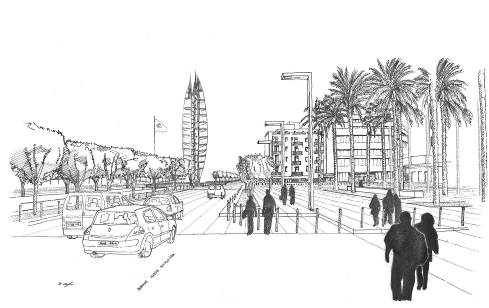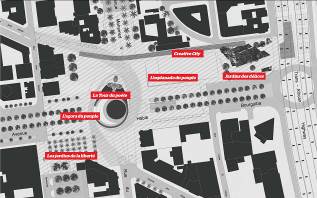Submitted by WA Contents
Revolution Tower,World Social Center (WSC),Tunis,Tunisia
United Kingdom Architecture News - Aug 11, 2014 - 11:28 8619 views

Architectural Design Of The Revolution Tower ,World Social Center (WSC) as well as The Urban Planning and Design of its Immediate Surroundings
Initiated by the foundation Symboles, the project is situated at the intersection of two main axes in central Tunis. The project includes the redesign of the Square of 14 Janvier and its surroundings as well as the construction of the World Social Center (WSC) Tower.
This project reflects the political will to express the ideological and social changes brought about by the Tunisian revolution that took place between December and January 2011.

Supported by competent political authorities, the project was managed within the foundation Symboles by the innovation adviser of Tunisian President Monsef Marzouki and monitored by his cultural adviser.

As an unprecedented project in the Arab world, the complex proposes a new vision for public space in the heart of the Tunisian capital by creating different types of civic space that are associated with multiple democratic practices. For example: the People's Agora at the center of the Square of 14 Janvier, renamed as the Square of the People; the Promenade of the People, with fountains dedicated to the martyrs of the revolution; the Garden of Liberty and the Garden of Delights; and the WSC tower which is houses spaces dedicated to social, economic, and artistic innovation.

The project's design process reflects and embodies the hopes and possibilities brought about by the revolution as well as their social, economic, cultural, artistic, architectural, and urban implications.

The studies were carried out by the Philippe Barriere Collective (PB+Co) with the local architectural firm Studio 3, and the engineering firm MB&Co. The project began in May 2012 and was abandoned in the spring of 2013 due to the political and economic degradation of the country.

The project for the redesign of the Square of 14 Janvier modernizes the paradigm shift brought about by the January 2011 revolution that took place in the heart of Tunisia's capital.
The history of the Square reveals that its symbolic presence was not created by the monuments praising historic figures that were built at its center but rather by the events that led to their deconstruction. Little by little, the heroes were replaced by the people. The people are the final players in a drama whose final, past, and present narration retraces the emancipation of the place. The square reflects this emancipation; it is the site of its struggle and the expression of its freedom.
Rather than replace one monument with another, the architect proposes to create spaces that are both receptacle as well as pro-active connectors. They create places of appropriation as well as representation, offering to the people the possibility to participate directly in the making its history.

It is thus not a monument but a hybrid infrastructural complex, engaging the real and the virtual (architectural, urban, digital). This built complex is the product of a meticulous study of the existing urban context and its harmony with the symbolic ideas of the project imagined by the Symboles Foundation.
The goal of the project is to reincarnate the values created by the revolution (democracy, solidarity, transparency, dignity) as well as those related to social and technological innovation (made possible through the usage of the virtual tool). This project metamorphosizes the traffic circle of 14 Janvier into a place teeming with life and cultural exchanges and offers new urban experiences to Tunisians. It provides services dedicated to daily social activities, spaces for the democratic celebration of the masses, and spaces for performances, exhibitions, artistic expression, and exchange.

The footprint of the urban design project is roughly 75,000 m², the pavilion levels of the tower hold 1,460m², the ground floor dedicated to reception and services holds another 150 m².
1- The People’s Square (the Agora, a space for debate and performances – Phase 1)
As a place for democratic debate and its civic expression, the People’s Square is an agora that links the two promenades of Avenue Habib Bourguiba. It is simultaneously a center for assembly, communication, and place for direct access to the tower. Conceptually, its footprint reproduces the Tunisian flag. The symbolic order of the flag frames its formal footprint. This topological impression, created by duplicating the Tunisian symbol within the symbol of democracy (the agora), binds them together and creates a steadfast and important connection.

2 - The Promenade of the People (A vast space of assembly and of celebration – Phase 2).
This promenade enables the assembly of the masses yet it can become a water basin on days without assembly. It is also a commemorative space for the martyrs of the revolution. Metal panels dedicated to each of the 338 martyrs are embedded onto the surface of the basin, emitting foam that progressively transforms into interactive fountains, filling up the inclined basin at the rhythm of the tidal cycles. These fountains represent the eternal renewal of the lifecycle.

3 – Revolution Tower (World Social Center (WSC) – Phase 2)
Initially, the tower was named initially “Tower of the poet,” in honor of Aboul Kassem Chebbi, by the presidential innovation adviser. After receiving active support from Microsoft for its programming, it became the World Social Center. The WSC is a virtually managed place that is dedicated to social innovation, technology, and social entrepreneurship. It houses online services (see www.worldsocialcenter.com) with functional spaces including: spaces for learning and exchange, a multimedia library and documentation center, a museum for social innovation and worldwide social movements, solidarity support group services, offices and meeting spaces, and a panoramic cafeteria.

At 78 meters tall, the tower has eleven “pavilion” levels with a total of 1460m², linked by a tensile structure and organized in ascending or descending spirals above a 150m² ground floor reception area. The upper pavilion levels are multifunctional and can be used either independently or jointly. They can be combined vertically as needed and can house interactive audio and video installations that vary according to the subjects of exhibitions.
4 - The Garden of Liberty and Garden of Delights (Public gardens planted with trees – Phase 3)
These gardens re-establish the relationship between man, nature, and culture by restoring the importance of the respect for the environment. The garden of liberty faces the Ministry of the Interior and symbolizes it by shading it. The garden of delights is filled with nourishing trees such as date, avocado, kiwi, citrus fruit, and passion-fruit trees, recalling the generosity of nature when it is cultivated and respected.

site plan process

axonometric early study



All Images © Philippe Barriere Collective (PB+Co)
Project Facts
Official project title:Architectural Design Of The Revolution Tower ,World Social Center (WSC) as well as The Urban Planning and Design of its Immediate Surroundings
Location:Square of 14 Janvier, Tunis, Tunisia.
Client:Fondation Symboles, Tunis, Tunisia.
Architects:Philippe Barriere Collective (PB+Co)
Philippe Barriere with Matthew R. Pauly, Hughes St Hilaire, Nicolas Wojcik, Charles Gretas, Yoann Plourde, Ottavy Thibault, Jonathan Lajchter, Samuel Pouliot, Sébastien Lequeux, Catherine Bouchard, Alexandre Hamlyn, Emmanuelle Cardu Gobeille, Maher Bellaj (Tunisia).
Local Architects:Studio 3, (Iheb Guermazi, Adnen Ben Tanfous), Tunis, Tunisia.
Project Managers:Philippe Barriere, Maher Bellaj (Philippe Barriere Collective) - Adnen Ben Tanfous (Studio 3), Tunis - Michel Bertrand (MB&Co), Paris.
Structural Engineer:Pascal Pierre (Canada), Michel Bertrand (France).
Building Cost Engineer:MB&Co, Paris (France).
Local Engineer:Tarek Gorbel, Tunis (Tunisie).
Renderings:LMM, Mathieu Grenier Digital Artist (Canada).
Graphic Designer:Wiklo, Mohamed Souheil (Dubai).
Landscape Architects:Philippe Barriere Collective (Philippe Barriere, Sébastien Lequeux)
Project Area:78 000m²
Project dates:Studies began in May 2012
> via philippebarrierecollective.com